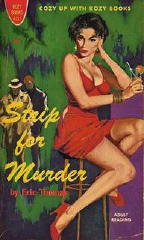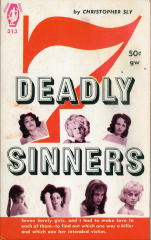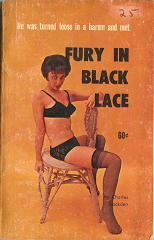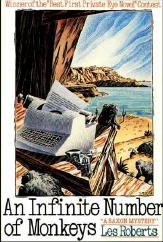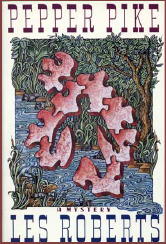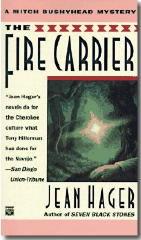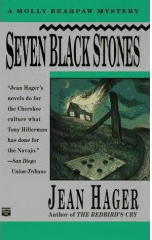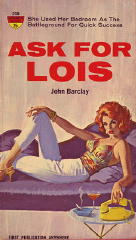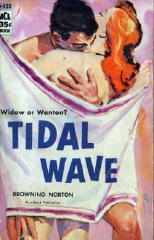March 2008
Monthly Archive
Wed 19 Mar 2008
FIRST YOU READ, THEN YOU WRITE
by Francis M. Nevins
Richard Wright (1908-1960) was perhaps the best-known and most written-about black novelist of the 20th century, but as far as I know no one except myself has ever pointed out the debt he owes to Cornell Woolrich. During the late Thirties when Wright was working on his first and finest novel, Native Son (1940), he is known to have been a voracious reader of the pulp mystery magazines like Black Mask to which Woolrich contributed dozens of stories.
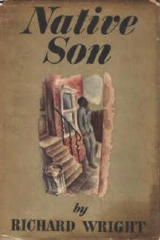
Native Son’s basic storyline of a young man wrongly accused of murder and running headlong through “streets dark with something more than night” was clearly inspired by Woolrich’s powerful suspense thriller “Dusk to Dawn” (Black Mask, December 1937; collected in Nightwebs, 1971).
During the last months of his life Wright was working on another crime novel, recently published in unfinished form as A Father’s Law, and it seems equally clear that here too he took his point of departure from Woolrich. In “Charlie Won’t Be Home Tonight” (Dime Detective, July 1939; collected in Eyes That Watch You, 1952) a middle-aged cop slowly becomes convinced that the criminal he’s seeking is his son. Woolrich’s cop of course is white. A Father’s Law deals with a middle-aged black cop who also becomes convinced that his son is a criminal.
If this is simply a double coincidence, it’s one that even Woolrich (who was prone to stretch coincidence to the outer limits) would have rejected. Any student of African-American literature who’s in need of an unexplored topic could do worse than to investigate the Woolrich-Wright interface in depth.
Silly mistakes in mystery fiction are not confined to nonentities like John B. Ethan, whose fond delusion that Zen Buddha was a person I discussed in my last column. Some of the biggest names have perpetrated howlers no less ridiculous.
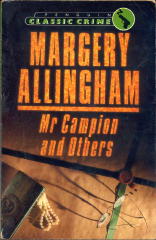
Take, for instance, Margery Allingham. “The Definite Article” (The Strand, October 1937; collected in Mr. Campion and Others, 1950) finds Albert Campion called in by his friend Superintendent Oates when Scotland Yard is asked by the “Federal Police” of the U.S. (by which I presume she means the FBI) to arrest and deport a “society blackmailer” whose extortion drove a young woman in New York to suicide.
Excuse me? Where’s the Federal crime? Where’s the Federal jurisdiction? Any doubts that Allingham knew nothing about the American legal system should be allayed a little further in the story when Campion asks Oates why the Feds got in touch with Scotland Yard instead of, say, “the Sheriff of Nevada.” Since when do states have sheriffs?
Richard Fleischer (1916-2006) directed some of the worst big-budget movies ever to issue from Hollywood but started out helming several excellent little specimens of film noir, perhaps the best known being The Narrow Margin (1952) and Violent Saturday (1955).
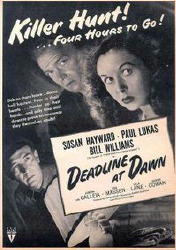
His memoir Just Tell Me When to Cry (1993) says very little about most of his noirs but includes a neat anecdote about a similar film he had nothing to do with. In 1946, as a novice at RKO, he sat in on a production meeting with tough-as-nails executive producer Sid Rogell and the well-known theatrical director Harold Clurman, who was helming his first movie. Fleischer doesn’t name the picture but, since Clurman made only one movie in his life, it has to be Deadline at Dawn, loosely based on Cornell Woolrich’s novel of the same name.
As Fleischer remembered the meeting, the first thing Rogell told Clurman was: “You don’t have forty days to shoot the picture. You’ve got thirty.” Then Rogell picked up the script, noticed that the first scene took place at night and called for rain (in film noir, what else?) and asked Clurman: “Rain? You know how much fucking rain costs?….What do you want rain for?” “For the mood,” Clurman told him. “Fuck the mood. No rain.”
Rogell was about to order Clurman to cut back on the number of people who appeared in the scene when the director interrupted: “How about dust? Lots of dust blowing everywhere. Can we afford dust?”
In the finished film the first scene takes place indoors – the confrontation between the blind pianist (Marvin Miller) and his predatory ex (Lola Lane) – and neither rain nor dust appears in the second scene, which is set outdoors but was clearly shot on a soundstage.
So many people have told me that I absolutely must see Infernal Affairs (2002), the Hong Kong movie which Martin Scorsese remade with Leonardo di Caprio and Matt Damon as The Departed, that I finally did it earlier this month.

The Asian film tells the same story as its U.S. counterpart – the duel between two moles, one planted in the mob years ago by the PD, the other planted in the PD by the mob – but much more tightly and cynically and without the graphic in-your-face violence that seems to have become a Scorsese trademark.
If you’ve hesitated because you’re unfamiliar with Asian action films and are afraid you won’t be able to tell the characters apart, I can assure you that this is not a problem. The wispy-mustached police mole in the mob (Tony Leung) could never be confused with the clean-shaven mob mole on the force (Andy Lau), and the only cop whose knows his mole’s identity (Anthony Wong) could no more be mistaken for the only mobster who knows his mole’s identity (Eric Tsang) than could Martin Sheen for Jack Nicholson in Scorsese’s version.
I do recommend, however, that Infernal Affairs be seen in letterbox. The panned-and-scanned version I got from Netflix eliminates far too much of each image from an intensely visual film – and one that goes far towards proving that noir has become a universal language.
Tue 18 Mar 2008
This is a continuation of a post made a couple of weeks back, based on a couple of discoveries made by Ken Johnson. First of all, here are the previous Addenda entries, repeated as they were given then:
FRITCH, CHARLES E(DWARD). 1927- . Add pseudonym Eric Thomas, q.v. For many years editor of Mike Shayne Mystery Magazine, beginning in 1979. Under his own name, a science fiction writer and the author of one private eye novel included in the (Revised) Crime Fiction IV.
_Negative of a Murder. Sydney, Australia: Phantom, pb, 1960. See: Negative of a Nude (Ace 1959).
Negative of a Nude. Ace, pb, 1959. Australian title: Negative of a Murder (Phantom, 1960). Setting: Los Angeles, CA. Add series character: Hollywood private eye Mark Wonder. Rewritten as Strip for Murder, by Eric Thomas (Kozy, 1960). As described by James Reasoner on his blog: “Mark Wonder […] is hired to recover some blackmail photos.”
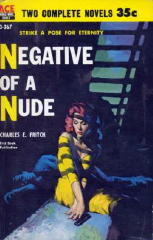
THOMAS, ERIC. Add: pseudonym of Charles E. Fritch, 1927- , q.v. Under this pen name, the author of two novels included in the (Revised) Crime Fiction IV; see below:
Psycho Sinner. Athena, pb, 1961. Add series character: Hollywood private eye Mark Wonder. Says James Reasoner on his blog: “Mark Wonder is hired by beautiful starlet Silvi McClair to find out who’s trying to kill her.”
Strip for Murder. Kozy Books, pb, 1960. Add setting: Los Angeles, CA. Leading character: private eye Christopher Sly. [Sly is hired by a stripper to recover some photos shed posed for.] According to James Reasoner on his blog, this book is “a very loose rewrite of Negative of a Nude (Ace, 1959), written under the author’s own name.
After these entries were posted, Ken emailed me with the following information:
“I have a different book called 7 Deadly Sinners by Christopher Sly, published by Athena Books in 1961, also featuring Sly as the lead character. This book was reprinted a year later by Carousel Books, another porn house, as Fury in Black Lace by Charles Brockden. Here’s the interesting part: Carousel Books were published by Frimac Publications which, it is my understanding, was owned by Charles Fritch and Jack Matcha.”
We’ll have to leave Frimac Publications to discuss another day — this was certainly news to me — but by pure coincidence, Jack Matcha’s entry was included in the same post as Charles Fritch’s.
For now, though, the following revised entries will appear in Part 25 of the ongoing online Addenda to Crime Fiction IV, by Allen J. Hubin. Until perhaps Mr. Fritch confirms that he wrote the following books, we’ll reserve the possibility that some plagiarizing may have been going on, as was common in the sleaze-based paperbacks of that era.
SLY, CHRISTOPHER. Possible pseudonym of Charles E. Fritch, 1927- ; other possible pen name: Charles Brockden; qq.v. Confirmed pen name for Mr. Fritch: Eric Thomas, q.v.
7 Deadly Sinners. Athena, pb, 1961. Setting: Los Angeles CA. Series character: Private eye Christopher Sly. [Sly is hired as a bodyguard to seven beautiful movie starlets.] Note: This book was rewritten as Fury in Black Lace, by Charles Brockden.
BROCKDEN, CHARLES. Possible pseudonym of Charles E. Fritch, 1927- ; other possible pen name: Christopher Sly, qq.v. Confirmed pen name for Mr. Fritch: Eric Thomas, q.v.
Fury in Black Lace. Carousel, pb, 1962. Setting: Miami Beach FL. Leading character: Private eye Nicholas Gamble. [Gamble is hired as a bodyguard to seven beauty contest contestants.] Note: This book is a rewrite of 7 Deadly Sinners, by Christopher Sly.
Sun 16 Mar 2008
KATHERINE HALL PAGE – The Body in the Fjord.
Avon, paperback reprint; 1st printing, November 1998. Hardcover first edition: William Morrow, November 1997.
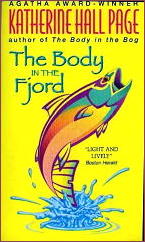
False advertising. Although her name is not on the front cover, it’s on the back cover and all over the first couple of blurb pages. This is supposedly a “Faith Fairchild” mystery, and it isn’t.
Faith Fairchild, for those of you who may not know, is a minister’s wife who lives in Aleford MA (a small fictional village somewhere outside Boston), and she’s solved many a case in her day, but not this one. She appears in a few pages at the beginning, a couple in the middle at the other end of a telephone call, and a few more at the end. That’s all.
Besides being a sleuth, a wife and a mother, and not necessarily in that order, Faith also has a catering business on the side. Working for her part-time is Pix Miller. What Pix knows about murder cases, she’s learned from Faith, but it hardly seems enough for her to tackle a book’s worth of adventure on her own – and it isn’t, I’m reluctantly sorry to say.
Pix and her mother Ursula head for Norway in this book – which should hardly come as a surprise, given the title of the book – where they try to track down Kari, the granddaughter of Ursula’s best friend Marit. Kari and Eric, her boy friend, had been working as stewards on a guided tour through the land of the fjords for a group largely consisting of Americans.
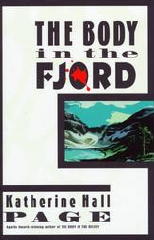
But Eric has been found dead, and Kari is missing. You might think it would be the utmost in audaciousness for two American women to come to a foreign country to do the job of the local police, and for the most part, you would be right. Mitigating this rather shaky basis of the story line is the picturesque quality of the tour they join, asking all kinds of questions as they go. Most of the central part of the book is as much a travelogue as it is a mystery, which is what we primarily signed up for, or at least I did, complete with recipes in the back.
Possible reasons for Kari’s disappearance: she and Eric may have stumbled upon a stronghold of Nazi survivors or sympathisizers; or a gang of smugglers of Norwegian artifacts; or a cabal of industrial spies in the oil business; or the romance between the two young people may have ended in a lovers’ spat and that is that.
Or any combination of the above. The police don’t make an appearance until page 167, leaving Pix and her mother the only ones on the scene asking questions and getting into serious trouble, especially Pix. It’s all a case of too much, which is quite a paradox, since it’s also a case of far too little.
Here’s a list of all the Faith Fairchild books, expanding upon the entry in Crime Fiction IV, by Allen J. Hubin. I’d recommend that you read one or another of this list instead, at least for the first one. If you’ve already read one, you’re probably way ahead of me on this.
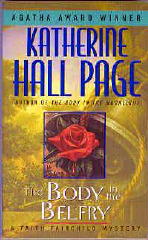
The Body in the Belfry. St. Martin’s 1990
The Body in the Bouillon. St. Martin’s 1991
The Body in the Kelp. St. Martin’s 1991
The Body in the Vestibule. St. Martin’s 1992
The Body in the Cast. St. Martin’s 1993
The Body in the Basement. St. Martin’s 1994
The Body in the Bog. Morrow 1996
The Body in the Fjord. Morrow 1997
The Body in the Bookcase. Morrow 1998
The Body in the Big Apple. Morrow 1999
The Body in the Moonlight. Morrow 2001
The Body in the Bonfire. Morrow 2002
The Body in the Lighthouse. Morrow 2003
The Body in the Attic. Morrow 2004
The Body in the Snowdrift. Morrow 2005
The Body in the Ivy. Morrow 2006
The Body in the Gallery. Morrow 2008
Thu 13 Mar 2008
LES ROBERTS – The Cleveland Local.
St. Martin’s; paperback reprint, December 1998. Hardcover first edition: St. Martin’s, November 1997. Trade paperback: Gray & Company Publishers, June 2005.
I’ll begin, not at the beginning, or not really, with a list of all the mystery fiction that Les Roberts has written. This I put together from what I found in Crime Fiction IV, by Allen J. Hubin, plus the bibliography that Mr. Roberts provides on his own website:
The Saxon Series: [A Los Angeles actor turned private eye.]
• An Infinite Number of Monkeys (St. Martin’s Press, 1987)
• Not Enough Horses (St. Martin’s Press, 1988)
• A Carrot for the Donkey (St. Martin’s Press, 1989)
• Snake Oil (St. Martin’s Press, 1990)
• Seeing the Elephant (St. Martin’s Press, 1992)
• The Lemon Chicken Jones (St. Martin’s Press, 1994)
The Milan Jacovich Series: [A private eye of Slovenian heritage based in Cleveland OH.]
• Pepper Pike (St. Martin’s Press, 1988)
• Full Cleveland (St. Martin’s Press, 1989)
• Deep Shaker (St. Martin’s Press, 1991)
• The Cleveland Connection (St. Martin’s Press, 1993)
• The Lake Effect (St. Martin’s Press, 1994)
• The Duke of Cleveland (St. Martin’s Press, 1995)
• Collision Bend (St. Martin’s Press, 1996)
• The Cleveland Local (St. Martin’s Press, 1997)
• A Shoot in Cleveland (St. Martin’s Press, 1998)
• The Best-Kept Secret (St. Martin’s Press, 1999)
• The Indian Sign (St. Martin’s Press, 2000)
• The Dutch (St. Martin’s Press, 2001)
• The Irish Sports Pages (St. Martin’s Press, 2002)
Stand Alones:
• The Chinese Fire Drill (Five Star, 2001)
• The Scent of Spiced Oranges (Five Star, 2002)
Here’s the real beginning, the first sentence of The Cleveland Local: “It was a black-and-white-movie morning when I opened my office, looked out the window down the Cuyahoga River, and saw the angry thunderheads hunkered over Lake Erie.”
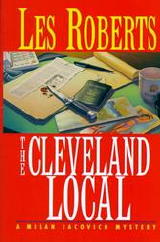
And here’s how the man pronounces his name: MY-lan YOCK-o-vitch, which he proudly makes sure the reader knows by page 3. Milan is an ex-football player and pretty much of a blue-collar kind of PI. He knows his way around every section of Cleveland, though, from the ethnic neighborhoods where he grew up to the ritzier parts of downtown and areas where the richer people live.
In The Cleveland Local he’s hired to tackle a rather cold case, that of the shotgun murder of a young professional lawyer on the Caribbean island of San Carlos ten weeks earlier. Obviously there’s no way the Cleveland cops can get involved, so the case is steered Milan’s way. The dead man’s sister, also an attorney, is picking up the tab.
What Milan can’t understand is why the dead man’s father, a noted well-to-do labor attorney, wants nothing to do with the investigation, making him wonder if the sister might be right, and that there’s a local connection, not just another botched robbery attempt in a foreign country and international resort area.
And of course there is. That’s almost not the point. What Roberts is equally interested in, besides the mystery, is to illustrate why and how he loves the city of Cleveland, the ins and outs, the people who run it, mostly behind the scenes, in a fictional paean to the town, with a hint of melancholy for the older days. There’s also some introspective father-son stuff involved as well, without being overly blatant about it, plus a generous hint of a budding romance. (Milan is divorced from his two boys’ mother.)
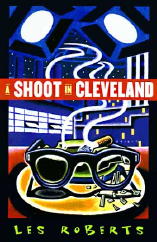
Milan’s technique consists of asking good common sense questions, persistence, a tough guy attitude (which at over 40 he can still back up) and persistence. An excellent combination, marred by the fact – and I dislike having to bring it up – by the relative weakness of the mystery. The motive for the murder seems too slight, the method too complicated, and people in retrospect don’t seem to have behaved in appropriate fashion to it.
Can I say that and still say that I enjoyed the book? I can, and if you didn’t notice, I just did. I should also point out, as many of the reviewers on Amazon also do, that the ending is one that will have readers immediately reaching for the next book in the series, which – thanks to the bibliography above – would have been A Shoot in Cleveland. It looks like a must read to me.
Wed 12 Mar 2008
I’ve not been able to do much posting here on the blog this week, but I hope to get back in the routine again soon. Pushing me in the right direction this morning was Al Hubin, who sent me Part 25 of the online Addenda to his landmark bibliography Crime Fiction IV, and I was able to upload it this afternoon.
Follow the first link directly to Part 25. The second one will lead you to the main page, which has a little more information about what this long ongoing project is all about.
There are no major pieces of information in this installment, only a slow but steady accumulation of answers to trivia questions, perhaps: newly identified settings, corrected publication dates, added movies or TV films based on mystery novels, newly discovered series characters, new editions of old books under new names or titles, on and on. Even though the cutoff for titles is the year 2000, additions and corrections like these keep coming in.
A small percentage of the information, by the way, has been previewed on this blog over the past few weeks. Al sends me the basic data, and eventually I expand and annotate the individual entries. I’ve not yet had a chance to do any of that for Part 25, but it’s on my agenda of things to do over the next few days.
Mon 10 Mar 2008
JEAN HAGER – Sew Deadly.
Avon, paperback original. First printing, December 1998.
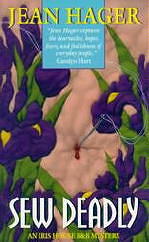
At one time Jean Hager had three different mystery series going, but while I’m not 100% sure, there doesn’t seem to have been any books to appear from her in a while. She was born in 1932, so if she happens to be retired from writing, as seems likely, she’s had a very decent career to show for it.
Ms. Hager wrote romances in the beginning, under both her own name and under several pseudonyms, before edging her way into mystery fiction by writing Gothics (as Amanda McAllister and Sara North) in the late 1970s. Her first true detective novel may have been The Grandfather Medicine in 1989 — but let’s do it the easier way. Here’s a complete list of all the books in each the three series that I mentioned just a minute ago, thanks primarily to Crime Fiction IV, by Allen J. Hubin:
Chief Mitchell Bushyhead: [half-Cherokee and head of the four-man police force in Bushkin, Oklahoma]
The Grandfather Medicine. St. Martin’s, 1989.
Nightwalker. St. Martin’s, 1990.
Ghostland. St. Martin’s, 1992.
The Fire Carrier. Mysterious Press, 1996.
Masked Dancers. Mysterious Press, 1998.
Molly Bearpaw: [a major crimes investigator and advocate for the Cherokee Nation of Oklahoma]
Ravenmocker. Mysterious Press, 1992.
The Redbird’s Cry. Mysterious Press, 1994.
Seven Black Stones. Mysterious Press, 1995.
The Spirit Caller. Mysterious Press, 1997.
Tess Darcy: [owner of the Iris House, a bed-and-breakfast in Victoria Springs, Missouri]
Blooming Murder. Avon, pb, 1994.
Dead and Buried. Avon, pb, 1995.
Death on the Drunkard’s Path. Avon, pb, 1996.
The Last Noel. Avon, pb, 1997.
Sew Deadly. Avon, pb, 1998.
Weigh Dead. Avon, pb, 1999.
Bride and Doom. Avon, pb, 2000.
Relative to the Tess Darcy books, there’s a long online interview with Jean Hager about the series at http://bandb.about.com/library/weekly/aa060898.htm.
Any mystery novel with an amateur female detective, especially one who operates a bed-and-breakfast establishment, is going to be called a “cozy,” no matter that two people are murdered in it, and more or less on stage rather than off, one of them in fairly gruesome fashion. (While sometimes I wonder exactly how cozy “cozies” really are, I’m not going to argue, or least not here.)
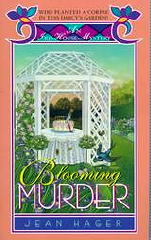
Probably because a B&B can’t have too many murders take place in it and stay in business, the primary setting of Sew Deadly has shifted by this time, the 5th book in the series, to the local seniors’ center, where Tess volunteers during the winter months, with no reservations in sight until March.
The first victim comes as no surprise. It is a meddlesome little old lady who lives in near poverty and seems to delight in finding various ways of annoying her fellow seniors, even to the extent of a little minor blackmail, just for fun. (The second to die is more of a shocker, as I mentioned above, both as to who the victim is and the manner of death.)
It does mean that there are plenty of good suspects, including the dead woman’s nephew and his supposed wife, who just happen to be visiting to make sure he’s remembered in her will, for whatever small amount it might be. And because Jean Hager as an author is quite good as describing what might have been totally stereotypical regulars to the senior center, the detective work is for the most part very well done — and in fact the emphasis is on the detective work, and not Tess’s love life, which seems to be moving well enough along so as not to cause anybody any concern.
Perhaps you noticed that I used the phrase “for the most part.” The killer is fairly obvious to spot, but while there are lots of clues planted along the way, some of them leading to dead ends, of course, the clincher is not discovered until page 202 (of a 210 page book), meaning that Tess knows for sure only a fraction of a moment before the reader does.
If the reader has been paying attention, that is. The end result is an “almost but not quite” fair play detective story, but in some cases, like this one, the “almost” is almost good enough.
Sat 8 Mar 2008
ERLE STANLEY GARDNER – The Case of the Fan-Dancer’s Horse.
Detective Book Club; hardcover 3-in-1 reprint, July 1947. Hardcover first edition: William Morrow & Co., 1947. Paperback reprints: Pocket 886, 1952 (with many additional printings); Ballantine, October 1992.
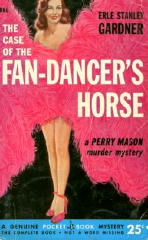
Start out with a serious automobile incident that leaves one car on its side in a ditch. When Perry Mason and his secretary Della Street observe the accident, they (a) get the occupant of the car to safety and (b) check out the trunk to find two very fine ostrich-plume feathers and a pair of white dancing slippers. Ever think of writing a mystery yourself? What sort of story could you come up with from here?
Probably not one as complicated and far-fetched as this one. Don’t even think of trying to compete with a master in his prime. More than one fan-dancer is involved. There are two, and one is using the name of the other. One has a horse — hence the title — and it seems to have disappeared. It may have been wounded, or it may have a bullet in its saddle, and in any case it’s missing.
When the husband of the one with the horse, the real Lois Felton, is murdered, a timetable of the people visiting his room that night takes up nearly half a page. Plus of course the fact that one fan-dancer looks a lot like the other, and which one is telling the truth about her story? It also makes for some great courtroom theatrics, and of course isn’t that what you read a Perry Mason novel for? (If you were to tell me that you read a Perry Mason novel for the characters, I would be more than amazed. I would be dumbfounded.)
It think it all fits together. I was puzzled, though, as to how Perry knew on page 27 that the fan-dancer he saw in the previous chapter was a ringer, and I still am. An explanation never turned up, and I kept waiting for one. And that’s what kept me entirely off-balance the rest of the story, and that’s why I never would have figured out who did it on my own. That’s my excuse, anyhow, and I’m sticking to it!
[UPDATE] 03-08-08. If you’ve been paying attention, you should have been expecting this review, right? Well, here it is. But to maintain a semblance of the unexpected, what you won’t see here is the cover of that Detective Book Club volume for the third time, and you’re welcome.
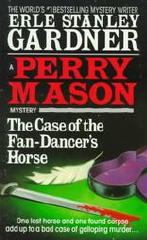
If I may, however, let me introduce a plug for those old 3-in-1 one books. If you like to read vintage detective fiction but you’re on a limited budget, then you can still pick them up cheaply on eBay, especially in bulk. They do seem to be disappearing from bookshops. Once up a time you could find at least a shelf full of them in every used book store you went into. No more. Maybe the store owners have gotten tired of clearing the dust off of them, or they’ve gotten confused with multi-book Readers Digest editions, and into the landfill they went.
As for Erle Stanley Gardner, I’ve probably mentioned this before, but the Perry Mason novels were the first mysteries I cam across, once I was allowed into the grown-up section behind the librarians’ desk, along with a Tommy Hambledon tale or two. Once found, I was hooked. I think I read three Mason’s in the first day, but I’m probably exaggerating there.
Some 50 years later, I’m afraid I’m seeing the flaws in the Gardner oeuvre. Not in the lack of personal lives for the primary players, but in the logic behind their thinking. I didn’t notice the gaps in the plots then, but I’m beginning to now, more and more, as I attempt to revisit my past.
Fri 7 Mar 2008
MARTHA GRIMES – The Case Has Altered.
Onyx; paperback reprint, November 1998. Hardcover first edition: Henry Holt & Co., October 1997.
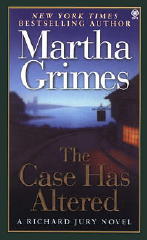
Yes, in case you were wondering, and I realize that you probably weren’t, there are authors whose mystery fiction just doesn’t — how shall I say this? — work for me. Take Martha Grimes, for example. For all of her popularity — she has to be, since this is the 14th of 20 cases of Scotland Yard Superintendent Richard Jury that she’s written about, along with four adventures of 12-year-old Emma Graham (about whom I otherwise know nothing at all) and a small assortment of stand-alone’s — I’ve never been able to finish one before, and believe me, I’ve tried. In fact, if you really must know, I nearly quit on this one after exactly 73 pages in.
I know the number of pages because that’s when I stopped and wrote a first version of this review — and by the time the next morning had rolled around, I’d thought better of it. At least I got it out of my system.
I almost never quit on a book. I figure that when the going gets tough, it’s just me, and in all fairness, I can’t write a review of a book I hadn’t finished, now could I? So with The Case Has Altered (the name of an English pub, as usual) firmly back in hand, I continued on to the end, and all in all, I’m glad I did.
But here’s the crux of the problem. There is a knack that the writer of a series of detective stories, all with the same leading characters, has to have, or so it seems to me. And that’s to introduce these people clearly and eloquently to the reader who’s starting with the book he or she has in her hand so that at least they have an idea of which way is up and where that part of the story is going.
This is especially true, as it is in The Case Has Altered, when a good part of the story has to do with the relationships between two and maybe three of the characters, and it’s crucial to know exactly what they are. At the same time, of course, you’ve got to do it without boring to tears the ones who’ve been along for the ride since book one. (A cover image of that very same book one is shown below, left.)
Ms. Grimes, deliberately, one supposes — how else can one explain it? — goes for the non-boring approach, and the first-time reader is caught flat-footed and totally lost, caught up as it were in the middle of the second act when they’ve only just opened the book. Superintendent Jury seems to be in love with Lady Jennifer Kennington, and so’s his good friend Melrose Plant. Is there a competition there? Or was there? It is not clear, though it does become clearer — and even so, is this a relatively new love, or a long-abiding one?
And when Jennifer appears to be the number one suspect in a double killing in the Fens of Lincolnshire county, it is not all clear why Jury does not simply stop by and ask her. What’s up with this double killing, he might ask her, but perhaps less directly. No, he does not. There are telephones in this otherwise nearly timeless world in which Jury and his friends live, but are they used in the way that they’re intended to be used? No.
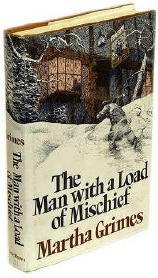
But perhaps he does not want to know the answer, or perhaps she is not so much in love with him as he is with her, or maybe neither loves each other very much at all, only an attraction perhaps? We the reader have no clue, at least the first time reader, for apparently the relationship has come up before, or maybe it hasn’t, because I don’t know, not having read any of the earlier ones.
Nor was I wrong in thinking that a couple of chapters are missing, because a reviewer on the Amazon website said the very same thing: when did Melrose Plant’s search for Jenny take place, since it came up later and had never been mentioned before?
There are, I hasten to add, some absolutely wonderful characters in this book. Absolutely wonderful, and the scenery of the Fens is described so beautifully (for what is essentially swamp land, that is) as to take you right there. Not that it’s likely I’ll ever go, and for now, I don’t need to. I’ve already been given a guided tour, and every part of the story that takes place there is exquisitely fascinating.
Melrose Plant also does a smashing (and utterly amusing) job impersonating an antiques appraiser while snooping around on Jury’s behalf. It is not entirely clear how Jury has so much free time to do the investigating he does on his own, and he does, but talk to Jenny? No. Not until page 192, after she’s been arrested, do we have any idea of what her side of the story might be, nor is she telling him everything then.
And my goodness. 427 pages. No wonder some of the twists and turns the plot takes don’t make any sense, or how some of the more minor characters are so poorly remembered (or not at all) when they are called upon to take their turn on the stage again.
One more thing, if I may. If I could advise Ms. Grimes about her characters, I’d tell her leave Melrose’s outrageous Aunt Agatha, her lawsuits and her other antics out completely, or at the very least, trim her role way back. This portion of the tale, included for comedy relief perhaps, goes absolutely nowhere, and do I mean nowhere? Yes.
Will I attempt another mystery written by Martha Grimes? Previous comments aside, I might surprise you and say yes, now that I know the characters, but in all likelihood, the honest answer is probably not, not right away. There are too many other books to read before undertaking another one that’ll require a whole week of evenings at bedtime to read, only to leave you with as many mixed feelings as this one does — the primary one being that of frustration.
Nor am I the only one. Read the other reviews on Amazon. They’re all over the board, just as my reactions are. I have no doubt that they’re honest, from out-and-out praise to “dump this one in the garbage pail.” Me, I’m somewhere in between, as I’m sure you can tell.
Wed 5 Mar 2008
Just so that you know that not all of the books in my basements are gothics, here are a few that I unboxed this past weekend coming from the other side of the crime fiction spectrum. These entries as I’ve annotated and expanded them will appear in Part 25 of the online Addenda to the Revised Crime Fiction IV.
BARCLAY, JOHN. Pseudonym of Jack Matcha, 1919- 2003, q.v.; other pseudonym John Tanner, q.v. Under this pen name, the author of one novel included in the (Revised) Crime Fiction IV. See below.
Ask for Lois. Monarch, pb, 1962. Add setting: Hollywood CA.
DAVIDSON, JOHN. Pseudonym of Charles Nuetzel, 1934- .
Delete: Blues for a Dead Lover. (Uptown, pb, 1962.) No crime content. [A jazz musician goes on a book-long binge when his girl friend dies in a plane accident.]
FRITCH, CHARLES E(DWARD). 1927- . Add pseudonym Eric Thomas, q.v. For many years editor of Mike Shayne Mystery Magazine, beginning in 1979. Under his own name, a science fiction writer and the author of one private eye novel included in the (Revised) Crime Fiction IV.
_Negative of a Murder. Sydney, Australia: Phantom, pb, 1960. See: Negative of a Nude (Ace 1959).
Negative of a Nude. Ace, pb, 1959. Australian title: Negative of a Murder (Phantom, 1960). Setting: Los Angeles, CA. Add series character: Hollywood private eye Mark Wonder. Rewritten as Strip for Murder, by Eric Thomas (Kozy, 1960). Says James Reasoner on his blog: “Mark Wonder […] is hired to recover some blackmail photos.”

MATCHA, JACK (B.) 1919-2003. Pseudonyms: John Barclay, John Tanner, qq.v. Born in New York City; degrees from Columbia (1942) and USC (1959). A reporter with the Baltimore Sun; playwright and TV writer in the 1970s. Taught at Los Angeles Southwest College circa 1978. Under his own name the author of one crime novel included in the (Revised) Crime Fiction IV.
Prowler in the Night. Gold Medal, US, pb, 1959. Digit, UK, pb, 1959. Setting: Los Angeles, CA.
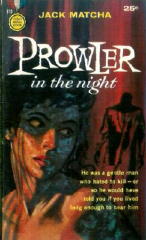
MERRICK, GORDON. 1916-1988. Actor from 1938-41; journalist from 1941-44, with the Washington Star, Baltimore Evening Sun, and New York Post. Beginning in 1947, the author of 14 novels, including three cited in the (Revised) Crime Fiction IV, one marginally; to this list add the one below:
The Strumpet Wind. William Morrow, hc, 1947. Reprinted as The Night and the Naked, (Pop. Library, 1952). Setting: France, 1944. [Espionage novel and love story “told against the turmoil of occupied France during the Second World War.”]
_The Night and the Naked. Popular Library, pb, 1952. See: The Strumpet Wind (Morrow, 1947).
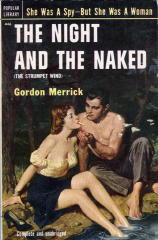
NORTON, (FRANK ROWLAND) BROWNING. 1909-1989. Born in Ohio; reporter and editor for the Youngstown Vindicator, 1941-1959. Professor of journalism, Ohio State University, 1959-71. Short story writer and co-author of one mystery novel previously included in the (Revised) Crime Fiction IV. To this add the title marked with an asterisk below.
I Prefer Murder (with Charles A. Landolf). Graphic, pb, 1956. Phantom, Sydney, Australia, pb, 1957.
* Tidal Wave, Ace, pb, 1960. Setting unknown: “Lake Iroquois.” [A man investigates the death of his brother by drowning.]
TANNER, JOHN. Pseudonym of Jack Matcha, 1919-2003, q.v. Other pseudonym: John Barclay, q.v. Under this pen name the author of two books included in the (Revised) Crime Fiction IV, , the first one of which is to be deleted:
Delete: Gambler’s Girl. Athena, pb, 1961. [The book is a western.]
The Killer Came Naked. Brandon House, pb, 1974.
THOMAS, ERIC. Add: pseudonym of Charles E. Fritch, 1927- , q.v. Under this pen name, the author of two novels included in the (Revised) Crime Fiction IV; see below:
Psycho Sinner. Athena, pb, 1961. Add series character: Hollywood private eye Mark Wonder. Says James Reasoner on his blog: “Mark Wonder is hired by beautiful starlet Silvi McClair to find out who’s trying to kill her.”
Strip for Murder. Kozy Books, pb, 1960. Add setting: Los Angeles, CA. Leading character: private eye Christopher Sly. [Sly is hired by a stripper to recover some photos she’d posed for.] According to James Reasoner on his blog, this book is “a very loose rewrite of Negative of a Nude” (Ace, 1959), written under the author’s own name.
WALTERS, HANK. Add as a new author’s entry.
Hood’s Mistress. Novel Books, pb, 1961.
Lucky Rape. Novel Books, pb,1960. Setting: Maine. [Tough noirish novel about hoodlums, bank robbery, rape and other assorted criminal activity.]
Wed 5 Mar 2008
A. B. CUNNINGHAM – Murder Without Weapons.
E. P. Dutton & Co.; hardcover first edition, 1949. No US paperback edition.
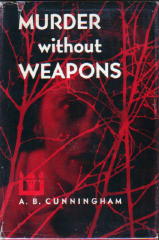
The backwoods region of the Deer Lick country is pretty nearly an alien world to me, a city feller for most of my life. (The exact state doesn’t seem to have been mentioned, but presumably it’s somewhere in Appalachia.) Even the title is one that makes more sense to an outdoorsman, seeing as the murder occurs with the death of a young girl going over the edge of a logging chute, a drop of all of fifty feet, frightened by the snuffling sounds of an approaching bear. A nonexistent bear, as it turns out, since dogs are not so easily fooled.
Sheriff Jess Roden is the reluctant detective — reluctant, that is, to claim there’d been murder done if in fact there hadn’t. To the trained, inquisitive mind of the inveterate mystery reader, there’s a surprising lack of questions asked, both by those who find the body and by her family, but in many ways the roles of country folks are as fixed, as categorized, as those of us city people, and things do work out a little more slowly and in their own way.
Roden does do a fine, though irrelevant, piece of detective work to impress an inquiring reporter, but I was disappointed with the ending. All the traipsing around at the top of the cliff where the dirty work was done seems highly unlikely, and at best, it needs a bit more explanation. The killer was fairly obvious, but even now I’m not convinced I know why he did it. [C]
— From The MYSTERY FANcier, Vol. 3, No. 2, Mar-Apr 1979. (Slightly revised.)
[UPDATE] 03-05-08. This book is one that was published as part of Dutton’s Guilt Edged series of mysteries, and as such it’s included in the online article that Victor Berch, Bill Pronzini and I did on them.
It’s still the only book by Cunningham that I’ve read, but I hope my comments didn’t suggest that such would always be the case. In fact, now that I’m (much) older, I have the feeling that I might enjoy one of Sheriff Jess Roden’s adventures even more than I did back then, in my youthful 30s.
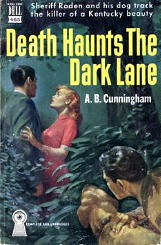
Most of his cases I’m more likely to have in paperback. Many of them were published as Dell mapbacks, others as digest-sized softcovers from Detective Novel Classics and so on. None are particularly collectable — after all Jess Roden is not a detective that anybody brings up in conversation very often today — so unless you want them in Fine or better condition, they should be relatively easy to find.
And oh, one last thing. I didn’t know then, and apparently in the book it was never stated or made clear, but Deer Lick is in Kentucky. Not only that, but it’s a real town, just up the road from Lewisburg. The population today is about 1400.
Which leads me to a question. Is there a smaller town in the US with as many mysteries taking place in the immediately surrounding area as Deer Lick? According to Crime Fiction IV, by Allen J. Hubin, there were 20 of them, plus one Roden adventure set in Texas, all published by Dutton:
# Murder at Deer Lick, 1939.
# Murder at the Schoolhouse, 1940.
# The Strange Death of Manny Square, 1941.
# The Bancock Murder Case, 1942.
# Death at “The Bottoms”, 1942.
# The Affair of the Boat Landing, 1943.
# The Great Yant Mystery, 1943.
# The Cane-Patch Mystery, 1944.
# Death Visits the Apple Hole, 1945.
# Murder Before Midnight, 1945.
# Death Rides a Sorrel Horse, 1946.
# One Man Must Die, 1946.
# Death of a Bullionaire, 1947. [Takes place in Texas.]
# Death Haunts the Dark Lane, 1948.
# The Death of a Worldly Woman, 1948.
# Murder Without Weapons, 1949.
# The Hunter Is the Hunted, 1950.
# The Killer Watches the Manhunt, 1950.
# Skeleton in the Closet, 1951.
# Who Killed Pretty Becky Low? 1951
# Strange Return, 1952.
« Previous Page — Next Page »





